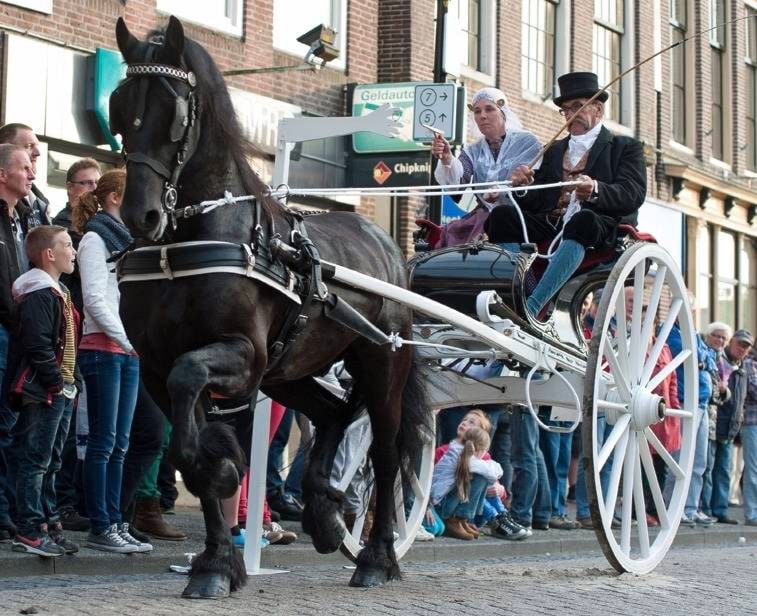The Friesian horse is one of the most iconic horse breeds in the world and one of the oldest from Europe. Often referred to as the ‘Black Pearls’ they have an imposing dark black appearance with a long thick wavy mane and tail.
The Friesian horse breed is part of the historical narrative of Friesland, the Netherlands and Europe. Also, ringsteken or ring riding is considered part of their cultural heritage. From the 13th century Friesian horses can be found in art, paintings and poetry.
The history of the breed is unique and these horses have been used in many facets. Today, with their increased desirability abroad and popularity in Hollywood movies, it is difficult to imagine that a little over half a century ago there were less than 1000 left.
In the Middle Ages the Friesian became known as a war and plow horse and following the 16th and 17th century they steadily gained favor with royalty as a baroque horse. During this time the Friesian horse was bred increasingly as a stagecoach/luxury horse as well as for a symbol of national pride. The Renaissance was a cultural and scientific revolution in the art of riding and breeding horses. Warfare changed as a result with military developments and the threat of the Ottoman Empire.
The new lighter way of riding set itself to harmony, suppleness and maneuverability. The traditional soldier tournament was refined to a dressage exercise to cultivate and further develop the partnership between horse and rider. Control of tempo, balance and hand to eye coordination had to be mastered. The ring riding was first and foremost a battle exercise in which the ring represented the enemies’ left eye. The French cavalry captain De Pluvinel described the practice as courier la bague. It was to become part of the classical dressage exercises which were taught at riding academies where cavalry and royalty trained. One of the surviving traditional academies today is known as the world famous Spanish Riding School in Vienna, Austria.
In the 17th century, the Dutch royalty still entertained themselves with tournaments which included ring riding amongst the events. Originally ring riding was strictly meant for the elite, but a steady increase of the bourgeoisie population meant more people could afford holding festivities and gradually turned the practice into a folkloric tradition. The ring riding that is practiced in contemporary society is based on that time period. This beloved tradition and exciting crowd pleaser still shows up mainly in the Dutch provinces of Friesland, North Holland and Zeeland as well as the countries of Denmark, Germany, England and even the United States.
The competition rules and stipulations can vary greatly between regions and provinces and all parties are content to keep it that way. In the Dutch province of Friesland, all participants are required to be driving a ‘Krompanelen Sjees’ or carriage. The Lady and Gentleman driver need to be wearing the traditional Friesian costume, which stems from around 1850, and of course a Friesian horse should be pulling their authentic Sjees. The man drives the horse in a large trot through the course where four rings are up for grabs.
The openings of the rings are two inches in diameter and are positioned within a ‘hand’ with stretched fingers. The height of the rings is adjustable and can vary from six to eight feet above ground. The participants are not allowed to take too much time and have to drive their horse in a strong and steady trot or there will be a penalty point given. No galloping is allowed. The rings are caught with a small wooden gun of about 25 cm length and have to be clearly ‘picked’ and shown to the jury after the ride.
Normally there are four rounds; in the first round each ring is worth one point, in the second round each ring is worth two points, in the third round each ring is worth three points and in the fourth round each ring is worth four points. In case of a tie, another round will be held as a run-off and if it remains a tie the jury will make their final decision based on the correct speed of the outfits. Traditionally there are prizes given to the winning team of the ring riding, as well as an additional award for the most beautiful and striking overall appearance.
Considering the difficulty of precision required in this event the natural abilities of the Friesian horse can be a valuable asset. Their calm, brave and secure demeanor combined with their elegant look and intensity has made them a favorite breed with competitors and audiences of the ring riding event all over the world.
For more information on the history of the Friesian Horse feel free to visit the Alberta Friesian Horse Association website at www.afha.ca. Our first annual ringsteken event will be held in downtown Ponoka, on July 25 on 51 Ave. from 3 to 5 p.m.
- Submitted by Inge Sybrandi
